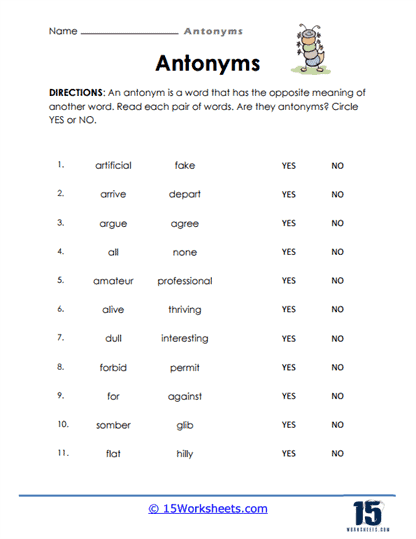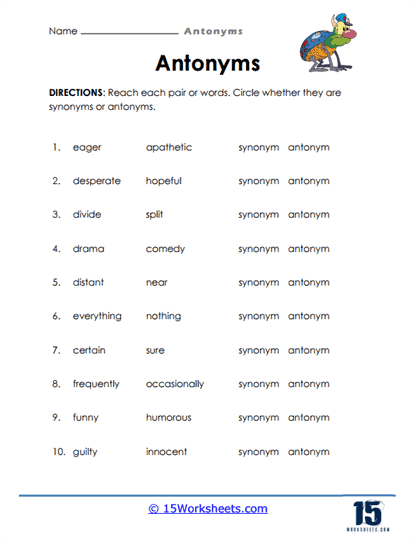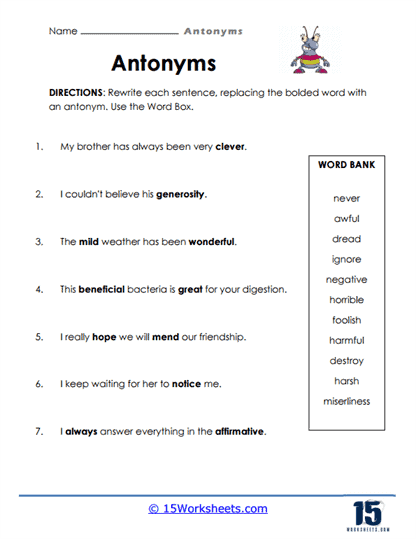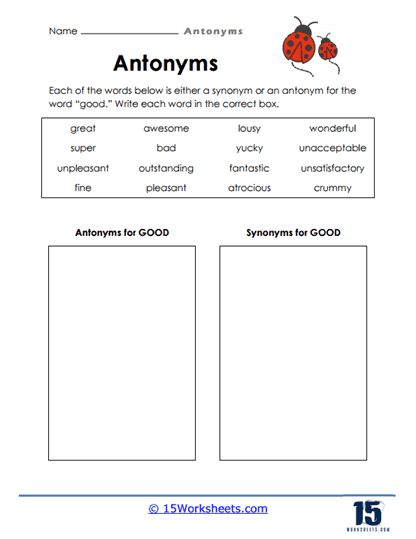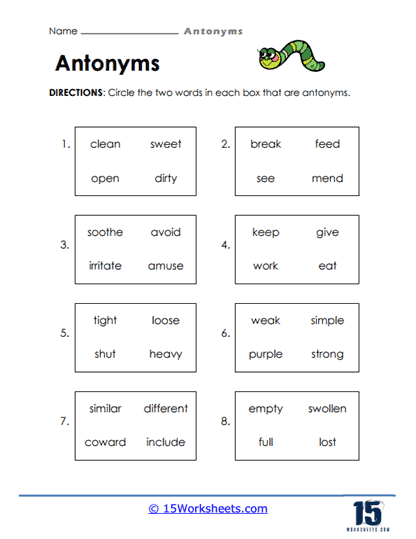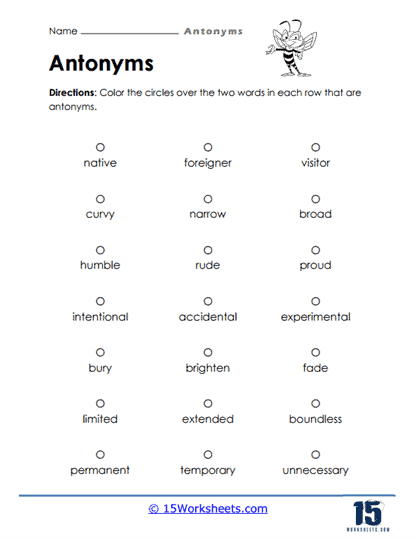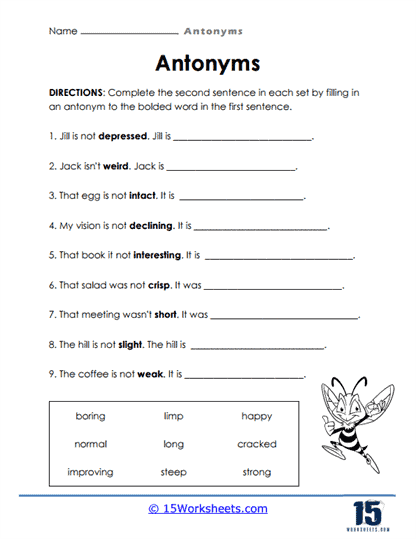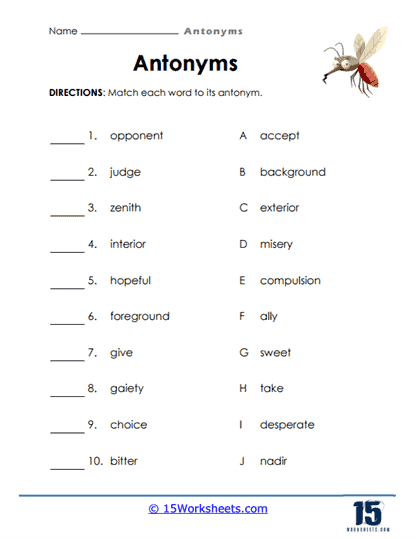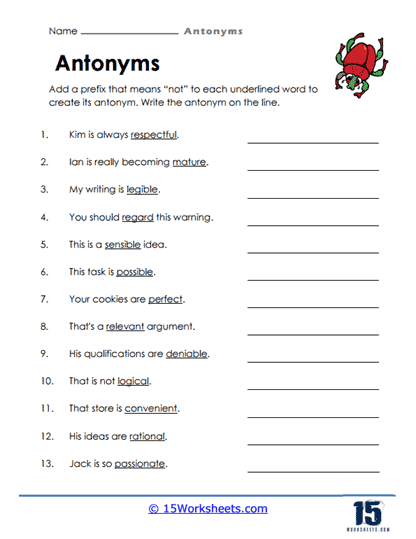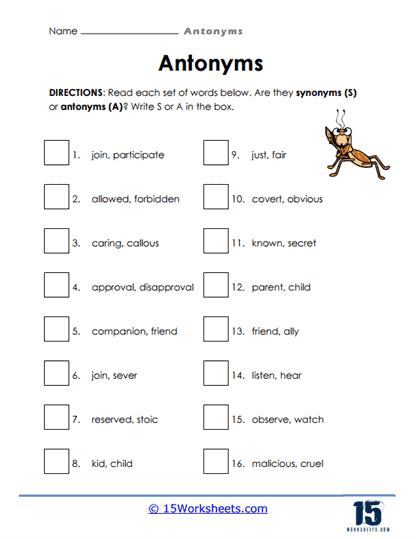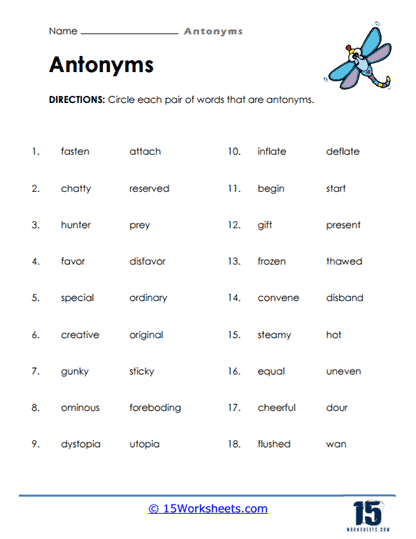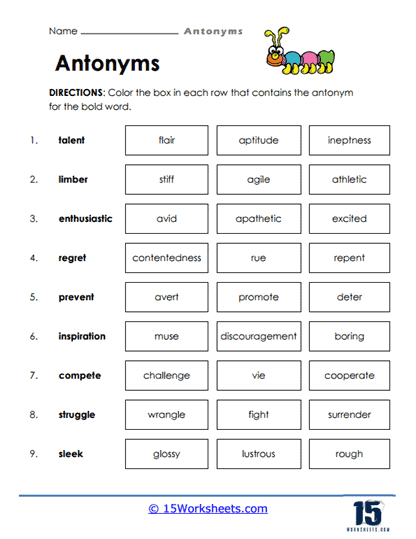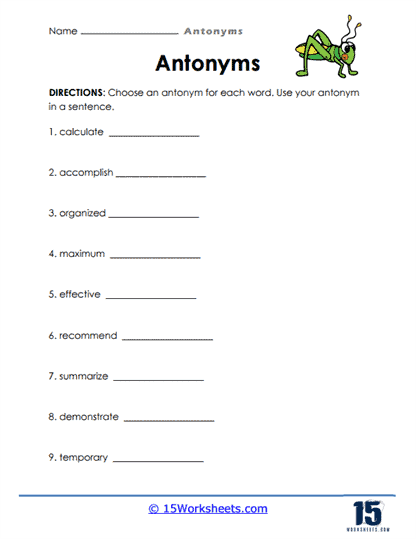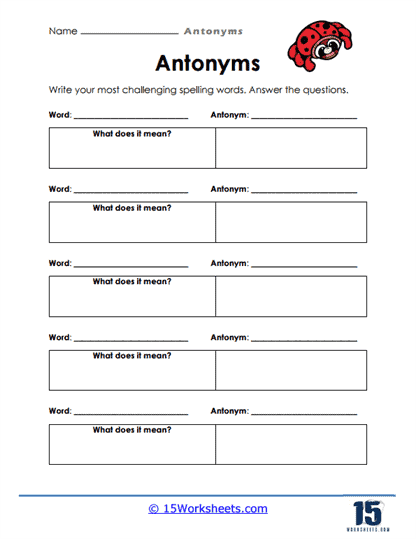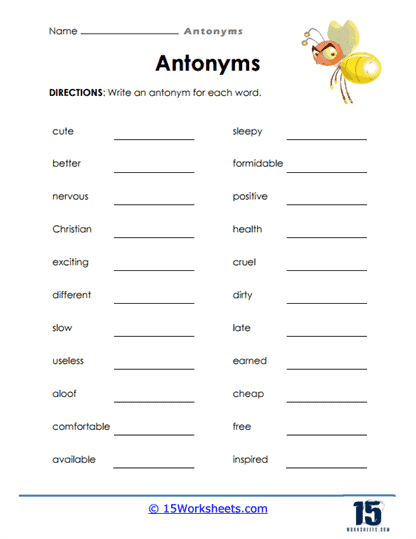Antonyms Worksheets
All About These 15 Worksheets
The collection of antonym worksheets provided serves as a comprehensive educational tool for helping students understand and practice the concept of antonyms, which are words with opposite meanings. These worksheets focus on several key skills that are foundational to language development and comprehension. Here’s a detailed description of the skills they aim to develop:
Vocabulary Recognition and Understanding
One of the primary skills these worksheets work on is vocabulary expansion. By introducing students to pairs of words with opposite meanings, such as “arrive” and “depart” or “artificial” and “natural,” students are not only expanding their vocabulary but also becoming familiar with nuanced word meanings. The repetitive practice of recognizing and identifying antonyms helps solidify their understanding of both common and less frequently used words. The various exercises encourage students to identify antonyms in different contexts, whether through word matching, sentence completion, or choosing correct antonym pairs.
Critical Thinking and Word Relationships
These worksheets also encourage students to engage in critical thinking by analyzing the relationship between words. By asking students to determine whether word pairs are antonyms, the activities foster deeper cognitive processing of language structures. Matching tasks, for instance, require students to link a word to its opposite meaning, while sentence rewriting exercises challenge students to think critically about the appropriate opposite of a highlighted word. These tasks go beyond simple recall and push students to think about how words function in context, reinforcing their comprehension of language patterns.
Sentence Structure and Contextual Usage
In addition to vocabulary, students are encouraged to apply antonyms within sentences. By replacing bolded words with their antonyms, students learn how changing a single word can alter the meaning of an entire sentence. This helps students understand contextual usage and how word choice influences meaning. Such exercises not only enhance vocabulary but also improve sentence structure understanding, as students must ensure that the antonyms they choose fit grammatically and contextually within the sentence.
Another aspect that these worksheets help develop is spelling. As students repeatedly engage with these word pairs and write out antonyms, they naturally practice spelling the words correctly. The more exposure they get to both familiar and new words, the better their spelling and word recognition become. Additionally, by completing sentence rewriting tasks, students get practice in forming coherent, grammatically correct sentences, which can enhance their writing skills over time.
Comprehension and Reading Skills
Some of the activities provided require students to read sentences or words carefully to discern the correct antonym. For example, filling in blanks with the correct antonym in a sentence or identifying antonyms among multiple choices involves reading comprehension. These exercises make students more aware of how opposites function in both oral and written communication, improving their overall reading fluency and comprehension abilities.
Engagement with Word Classification and Prefixes
In one of the worksheets, students are tasked with adding prefixes to words to create antonyms, which helps them understand how prefixes like “un-,” “in-,” and “dis-” change the meaning of a word. This is particularly useful for building vocabulary and recognizing word patterns in the English language. Understanding how these small units of meaning work expands students’ ability to deduce the meaning of unfamiliar words they may encounter in future reading.
Varied Learning Formats and Engagement
The variety of formats, from fill-in-the-blank sentences to word-matching exercises, keeps students engaged and reinforces the material in different ways. This varied approach ensures that students are not only passively learning but actively applying their knowledge in multiple contexts. Additionally, activities like circling or matching word pairs can also develop students’ ability to quickly and accurately identify antonyms, which is an important skill for standardized testing.
What Are Antonyms?
Antonyms are words that have opposite or nearly opposite meanings in a language. They help to express contrasting or opposing ideas and add variety and richness to language. Antonyms can be used to convey a different perspective or to create emphasis in communication.
For example, the word “hot” has an antonym “cold,” and the word “up” has an antonym “down.” Other examples include “happy” and “sad,” “big” and “small,” “fast” and “slow,” or “old” and “young.” Antonyms can belong to different parts of speech, such as adjectives, adverbs, nouns, or verbs.
Understanding antonyms helps broaden your vocabulary, allowing you to choose the most appropriate words to express your thoughts and ideas. A rich vocabulary enables clearer communication and enhances your ability to understand and be understood by others.
Antonyms provide a means to express contrasting or opposing ideas, which is essential for describing complex or nuanced situations. By using antonyms, you can convey your message more accurately and avoid misinterpretations.
They can also enhance your writing and speaking skills. Knowing antonyms helps you create more engaging and diverse written or spoken content. It allows you to vary your language, avoid repetition, and make your communication more dynamic and interesting.
A strong grasp of antonyms helps you better understand the meaning and context of texts you read. You’ll be able to interpret the author’s intent and analyze their use of language more effectively.
Learning antonyms encourages you to think critically about language and its nuances. This skill helps you analyze and evaluate information, fostering better decision-making and problem-solving abilities.
How to Identify Antonyms
Finding the antonym of a word may seem simple at first-just think of the “opposite,” right? But language is often more nuanced than that. Words can have multiple meanings, and their opposites depend heavily on the context in which they appear. To help you navigate this, here’s a practical, step-by-step process for identifying antonyms more effectively.
Step 1: Look for Prefix Clues
Many antonyms are created by adding a prefix to the original word. These include common negating prefixes like un-, in-, im-, dis-, non-, or anti-. For example, “honest” becomes “dishonest,” and “possible” becomes “impossible.” When you see a word with one of these prefixes, there’s a good chance it’s functioning as an antonym. Train yourself to recognize these patterns-they’re quick clues in identifying opposites.
Step 2: Understand the Context
The meaning of a word can shift based on how it’s used. Take the word “light”-it could mean not heavy (opposite: heavy) or it could refer to brightness (opposite: dark). Before deciding on an antonym, pause to consider the sentence or situation the word is in. This step is essential for choosing the right opposite and avoiding common mix-ups.
Step 3: Find a Synonym First
If you’re stuck, try finding a synonym-a word with a similar meaning-and then look for its antonym instead. For instance, if you’re unsure about the opposite of “generous,” try thinking of a synonym like “giving.” Then you might come up with “selfish” as the opposite of both. This two-step method often gets your brain moving in the right direction.
Step 4: Use a Thesaurus or Online Tool
Don’t underestimate the power of a good reference. A thesaurus-whether print or digital-usually includes both synonyms and antonyms. You can also use dedicated websites like WordHippo or Antonym.com. Just type in the word, and you’ll get a list of possible opposites. Think of these tools as your language GPS-they get you where you’re going when you’re not quite sure of the route.
Step 5: Practice, Practice, Practice
Like any skill, identifying antonyms gets better with repetition. Read widely, play word games, complete vocabulary worksheets, and challenge yourself with quizzes. The more you expose yourself to rich and varied language, the more naturally you’ll recognize word relationships, including opposites.
Step 6: Double-Check Your Work
Even when you think you’ve found the right antonym, take a moment to ask, “Does this really mean the opposite of the original word in this context?” A good antonym should make sense logically and grammatically in place of the original word. If it doesn’t, revisit the steps above until it clicks.

